心脏MRI检查课件
- 格式:ppt
- 大小:56.56 MB
- 文档页数:227
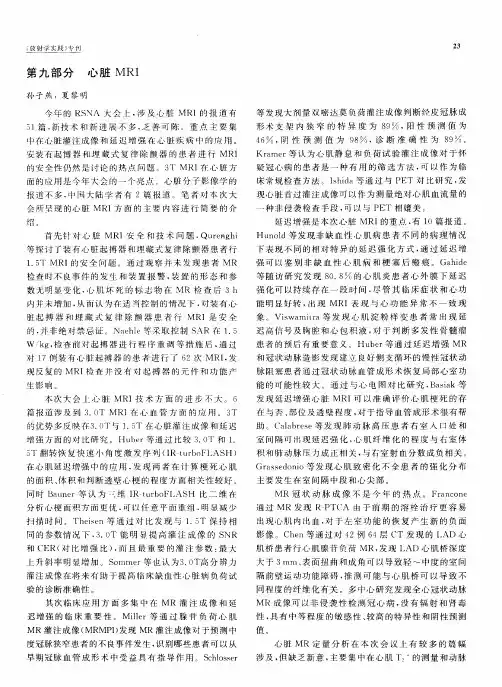
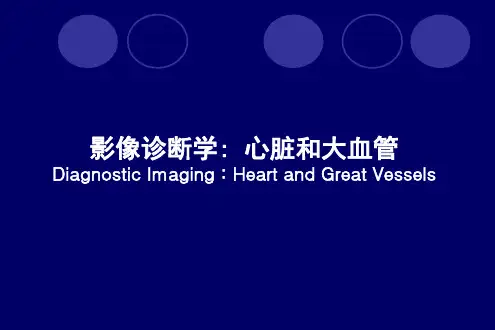

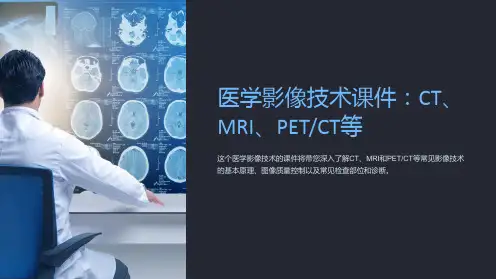

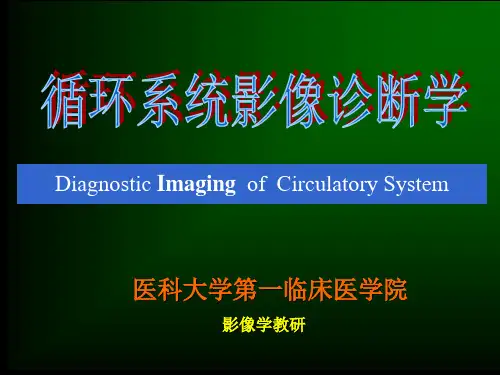



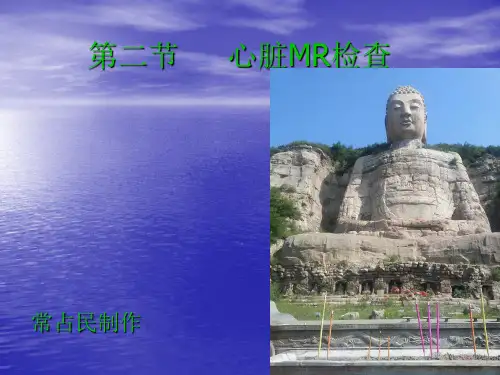

心脏MRI检查及应用(2)心脏MRI检查及应用⚫心肌组织特征的评估及量化⚫缺血性心肌病一、心肌组织特征的评估及量化心肌组织特征的评估评估心肌组织特征的方法:✓(1)MRI电影成像:通过室壁厚度定量进行判定,明显的节段性室壁变薄是心肌梗死的重要形态学改变✓(2)DCE-MRI:通过分析首过灌注和延迟强化来评估心肌活性✓(3)Mapping技术:可以量化心肌水肿和纤维化✓(4)用磁共振波谱(MRS):测定心肌组织代谢活性大量的动物实验及临床研究表明,DCE-MRI对心肌活性的检查有很高的准确性,其敏感性和特异性与心肌酶学检查相近。
它也是目前唯一能够判断心肌梗死透避程度的临床检查方法,从而对一个心肌活性的判断不再是单纯有或无的概念DCE-MRI评估心肌活性✓正常心肌组织的首过灌注略有强化且较均匀✓缺血心肌的首过灌注则会减低,延迟扫描可无异常✓坏死心肌在表现为延迟强化对比剂注入后将在5 min内被存活心肌快速排空,而坏死心肌则发生滞留现象由此可以很好地区分坏死心肌与存活心肌;这也是团注对比剂后5~10min 开始延迟扫描的缘故Radiology, 265(1), 23–32心肌组织特征的量化✓T1mapping和T2mapping能测量心肌病变的水肿量✓T1mapping可以定量评价心肌局限性或弥漫性纤维化✓延迟强化能识别心肌坏死和纤维化,但不能很好地检测弥漫性纤维化MR纵向弛豫时间定量成像(T1mapping)✓T1Mapping技术可对心肌的T1值进行定量测量来评估心肌的局部及弥漫性病变✓MOLLI序列是目前临床应用较多也较成熟的序列MOLLI序列使用心电门控连续在心脏舒张末期采集数据,此序列施加了两次反转脉冲在17次心跳内采集335(共11幅)图像,每次反转序列有3次心跳的时间间隔用于纵向磁化矢量的恢复,用符号表示为3(3)3(3)5,其屏气的时间约为16-20s,读出序列为稳态自由步进序列(SSFP)✓T1Mapping技术包括平扫T1Mapping及增强后T1Mapping在注入钆对比剂后12min及25min左右进行图像采集,对比剂用量为0.15~0.20mmol/kg在心室四腔心长轴位或左心室短轴位进行图像采集T 1mapping 主要参数包括:心肌增强前的平扫T 1值、增强后的T 1值以及心肌细胞外容积(ECV)✓平扫T 1值:测得的T 1值为心肌内在T 1值,其反映的是心肌细胞及细胞外间质的综合信号✓增强后T 1值:对比剂会缩短T 1值,增强后心肌T 1值减低细胞外间隙增大等病理改变(如心肌纤维化),可引起心肌增强后T 1值减低✓ECV :是指细胞外间质容积占整个心肌组织容积的百分比(正常人的ECV 约为21%~27%)ECV 只与心肌间质状态改变有关,心肌水肿、纤维化均可引起细胞外间隙扩大、ECV 增加T 1Mapping细胞外间隙增大等病理改变(如心肌水肿、纤维化)的平扫T1 值、ECV都高于正常,增强后T1值低于正常Radiology, 285(1), 83–91.二、缺血性心肌病缺血性心肌病✓根据缺血缺氧的程度,心肌组织主要出现三种受损情况:第一种顿挫心肌,在大多数情况下,顿挫心肌可以恢复成正常心肌第二种休眠心肌,受长期供血量减少的影响第三种是坏死心肌,不能恢复至具有正常功能的心肌✓冠状动脉狭窄后的侧支循环优先供应心外膜下心肌,心肌坏死首先形成心内膜下非透壁性心肌梗死,继而发展成透壁性心肌梗死✓心肌梗死是由心内膜向心外膜发展的,梗死周边受到损伤的心肌为可逆性心肌损伤区危险区可逆性心肌损伤区(可挽救区) 不可逆性心肌损伤区(梗死核心区)组织学心肌水肿心肌坏死✓T 2WI 可以显示(可逆性与不可逆性)心肌损伤区,即危险区;心肌延迟增强能够显示由于缺血引起的心肌不可逆性损伤,两者可以结合起来评价可挽救区的范围急性心肌梗死T 1Left: Comparison of MR imaging hyperenhancement (top), triphenol tetrazolium chloride (TTC) staining (middle) and myocardium at risk (bottom) (region without fluorescent microparticles) in an animal with a 1-day-old reperfused infarction. UV = ultraviolet. Right: Light microscopy views of regions 1 (not at risk, not infarcted), 2 (at risk but not infarcted), and 3 (infarcted) are shown on the right panels. Arrows = contraction bands. MR imaging infarct size and negative triphenol tetrazolium chloride staining zone have a smaller endocardial extent than does the area at risk depicted by pale blue patch on the fluorescent microparticles.✓定义:是指心脏的血液灌注减少,导致心脏的供氧减少,心肌能量代谢不能支持心脏正常工作的一种病理状态✓MR电影成像:节段性运动减弱✓DCE-MRI:灌注成像-缺血区低灌注,信号低于正常心肌延迟扫描-由于急性心肌梗死时常存在心肌的再灌注,延迟扫描可无异常表现Circulation Journal, 2009, 73(9):1577-1588First-pass contrast-enhanced perfusion MR images acquired with a saturation recovery steady-state free precession sequence during ATP stress in a patient with significant coronary artery stenosis in the left anterior descending artery. (A) Basal level, (B) mid-ventricular level, (C) apical level. The ischemic心肌梗死✓定义:冠状动脉供血急剧减少或中断,心肌发生缺血、损伤和坏死;冠状动脉闭塞时间持续大于20min,心肌细胞将发生不可逆损伤✓病理变化:11急性期亚急性期慢性期1-2周后坏死的心肌开始吸收、纤维化6-8周演形成纤维瘢痕T1WI、T2WI呈低信号心肌坏死及周围水肿T2WI呈高信号T1Mapping、T2Mapping T1Mapping、DCE✓定义:是指冠状动脉急性、持续性缺血缺氧所引起的心肌坏死✓MRI平扫:梗死区T2WI信号高(心肌水肿)✓电影成像:梗死区心壁薄,运动减弱,消失,收缩期室壁不增厚✓DCE-MRI:灌注成像-表现为梗死区不同程度的减低或充盈缺损延迟扫描-信号明显增高A patient with a subendocardial myocardial infarction. Steady-state free precession cine MR images in the diastolic (A) and systolic (B) phases demonstrate no regional wall motion abnormality. Late gadolinium-enhanced MR images in the short-axis (C) and long-axis (D) views show a subendocardial infarction in the anteroseptal wall (arrows). Myocardial viabilityis preserved in the infarcted areaA patient with a transmural myocardial infarction. Steady-state free precession cine MR images in the diastolic (A) and systolic (B) phases reveal akinesis and myocardial wall thinning in the anteroseptal wall (arrows). Late gadolinium-enhanced MR images in the short-axis (C) and long-axis (D) views demonstrate the transmural infarction in the anteroseptal wall and apex (arrows). Myocardial viability isnot preserved in the infarcted areaA patient with an inferior acute myocardial infarction. Cardiac magnetic resonance imaging (MRI) was performed 5 days after onset. Steady-state free precession (SSFP) cine MR images in the diastolic (A) and systolic (B) phases demonstrate mild hypokinesis in the inferior wall. Transmural myocardial edema in the inferior wall is observed as an area with high signal intensity on the black-blood T2-weighted MR image (white arrows) (C). There is no myocardial perfusion abnormality on the rest-perfusion MRI (D). Late gadolinium-enhanced MRI in the short-axis (E) and long-axis (F) views show the subendocardial infarction in the inferior wall (black arrows). The area of myocardial edema on blackblood T2-weighted MRI is larger than the area of infarction on late gadolinium-enhanced MRI.急性心肌梗死Radiology, 2005, 237(1):75-82.Bull's-eye representations of the percentages of involved segments in the patients with AMI.急性心肌梗死(AMI)✓心肌水肿:对于AMI患者,细胞及细胞周围组织发生水肿心肌水肿最早发生在冠状动脉闭塞后15分钟,在梗死后1周最明显,以后逐渐减轻,可持续6个月,为水肿的持续存在可能与血液引流不畅、肉芽组织内液体成分等有关✓微血管阻塞(MVO):是AML中一种常见的现象, 常存在于心肌持续缺血区域前壁和间隔壁梗死患者第1天、第1W 、第5W 、第6M 心脏MR 图像第1天危险区约为45%,第7天为24%,第35天为21%,第180天为27%心肌水肿在梗死后1周最明显,以后逐渐减轻,可持续6个月AMI-心肌水肿✓1周后测量AMI 患者最终梗死范围较准确AMI-心肌水肿✓T1mapping和T2mapping值可量化心肌水肿值,能更为客观、定量地反映急性心肌梗死心肌水肿程度和范围诊断标准:✓T2mapping:梗死周围水肿区T2WI信号强度大于远端正常心肌的2个标准差✓T1mapping:急性心肌梗死导致心肌细胞破坏、周围间质水肿,平扫T1值增加约(18±7)%、ECV增加、增强后T1值的下降约(27±4)%Radiology, 2010, 254(1):88-97Radiology, 285(1), 83–91.Cardiac LGE MR images, T2-weighted (T2w) MR images, and T2 and T1 maps in a 48-yearold man with lateral infarction. For quantitative analysis of lesion size, a large region of interest was placed in remote myocardium to measure mean signal intensities or mean relaxation times, including standard deviations. The threshold was set as greater than 2 standard deviations to define lesion size in the infarct area and was kept constant during follow-up. Meticulous care was taken not to include the blood volume or the epicardial fat in the measurements by precise placement of the endo-and epicardial myocardial borders, shown in the colored T2-weighted images. During follow-up, patchy myocardial areas with residual signal on T2-weighted MR images and with increased relaxation times were present; these areas are less pronounced on the T2maps than on the T1 maps in this patient.AMI-心肌水肿✓MVO导致血流灌注减少,对比剂不能到达此区域✓MVO在延迟强化表现为中央微血管阻塞区无强化,边缘心肌损伤区表现为环形强化✓MVO是AMI患者的重要预后因子,当梗死面积固定不变时MVO不可逆,为永久性阻塞,提示病人预后不佳Cardiovascular MR images demonstrate identification and quantification of infarcted tissue and MVO with LGE. Green contours = LV epicardial border, red contours = LV endocardial border, orange contours = region of interest in the remote normal myocardium.(a) High signal intensity is seen in the interventricular septum, demonstrating infarcted myocardium. Area of hypointense signal in the infarct zone indicates MVO. (b) Highlighted tissue is defined as myocardium with a signal intensity greater than 2 SDs of remote normal myocardium. (c) Yellow contour defines the infarct zone and includes the area of MVO. (d) Yellow contourdelineates the area of MVOShort-axis cardiovascular MR images from a 63-year-old man who had anterior ST-segment elevation myocardial infarction at presentation. Early after reperfusion, T2-weighted (T2W) images demonstrated increased signal intensity (myocardial edema) in the interventricular septum. Extent of edema gradually decreased and by 3 months was undetectable. LGE images from the same patient demonstrated almost transmural infarction in the septum. MVO is present at day 2 and 1 week after reperfusion (dark core in the infarct zone) but is undetectable at 1 month. Infarct size decreased during the 1st month afterRadiology, 2011, 261(1):116-126.AMI-MVO急性心肌梗死预测✓反向心室重塑是指衰竭的心脏能在形态学上进行有利的改变✓梗死范围和MVO是左室重构的重要预测因子✓广泛的梗死(梗死范围>30%)伴随MVO(MVO>2.5%)提示更差的预后MVO, dashed lines = infarct size.陈旧性心肌梗死(OMI)✓坏死心肌被纤维组织取代而形成瘢痕组织。